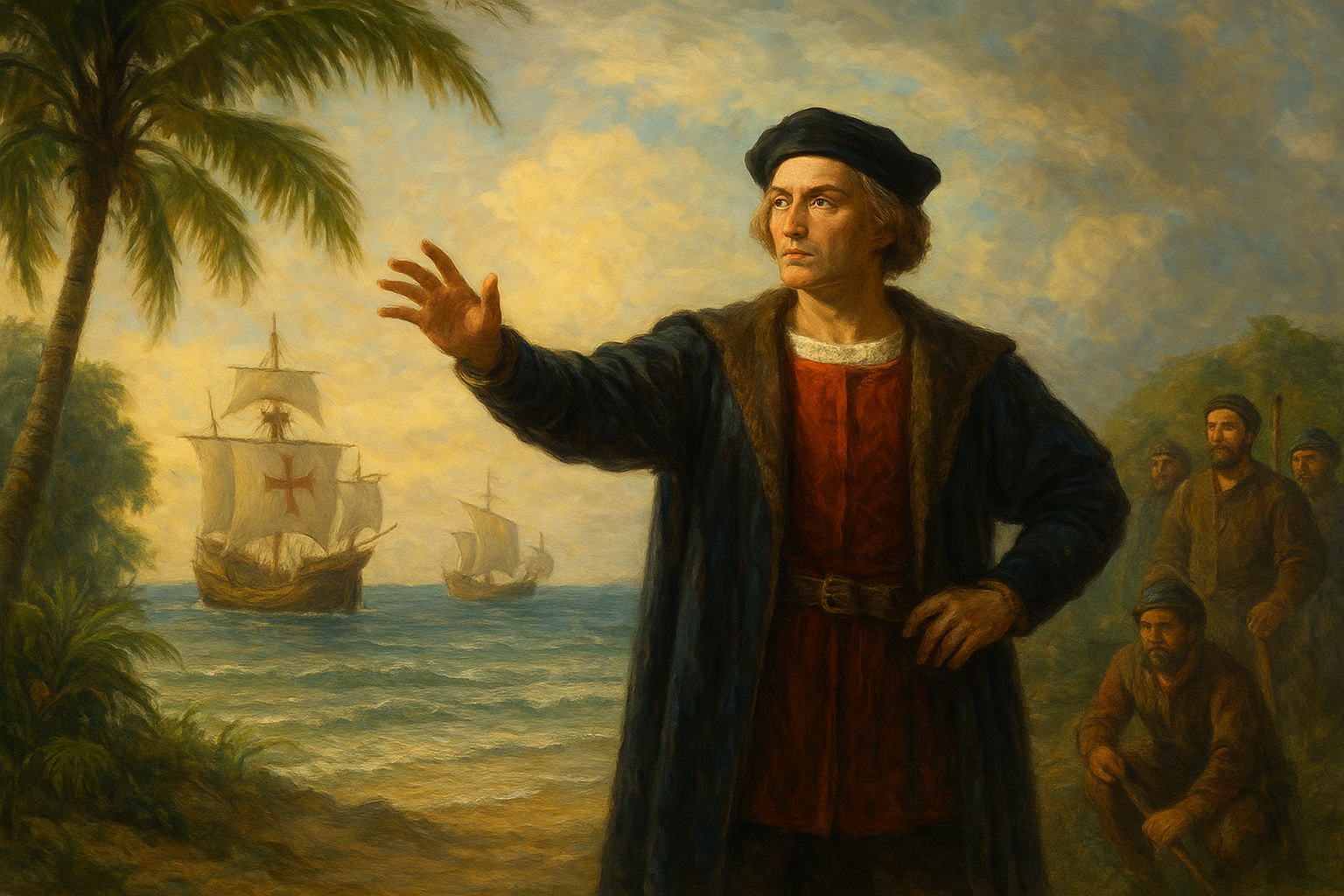Introduction
Few names in world history spark as much curiosity and debate as Christopher Columbus. Celebrated as the man who “discovered” the Americas, Columbus’s life story is a fascinating blend of ambition, exploration, and enduring legacy. His voyages changed the course of history by connecting Europe with the New World — an event that shaped global trade, culture, and geography forever. But who was Columbus, and how did his journey across the Atlantic alter humanity’s perception of the world?
Birth and Early Life
Christopher Columbus (Italian: Cristoforo Colombo, Spanish: Cristóbal Colón) was born between August and October 1451 in Genoa, a maritime republic in present-day Italy. His father, Domenico Colombo, was a wool weaver, and his mother, Susanna Fontanarossa, came from a modest family. Despite his humble origins, Columbus developed a deep fascination with the sea from an early age.
From a young age, Columbus worked as an apprentice in his father’s trade and later sailed on merchant ships in the Mediterranean. He learned Latin, Portuguese, and Spanish, studied cartography (map-making), and mastered navigational skills — all of which would become crucial for his later voyages.
Ambition and Vision: The Dream to Reach Asia
In the 15th century, Europe’s trade with Asia — especially for spices, silk, and gold — was dominated by overland routes controlled by Middle Eastern empires. Columbus believed there was a faster way to reach Asia by sailing westward across the Atlantic Ocean.
Though many doubted his calculations and the existence of land to the west, Columbus was convinced the Earth was smaller than most believed and that Asia could be reached quickly by sea.
After years of seeking support, his proposal was rejected by Portugal, England, and France. Finally, in 1492, the Spanish monarchs King Ferdinand II and Queen Isabella I agreed to sponsor his expedition, hoping to gain wealth and prestige from new trade routes.
The Four Voyages of Christopher Columbus
1. The First Voyage (1492–1493): The Discovery of the New World
On August 3, 1492, Columbus set sail from Palos de la Frontera, Spain, with three ships — the Niña, the Pinta, and the Santa María.
After more than two months at sea, he reached land on October 12, 1492, which he believed was the East Indies (Asia). In reality, he had reached an island in the Bahamas, marking Europe’s first contact with the Americas.
He later explored Cuba and Hispaniola (modern-day Haiti and the Dominican Republic) before returning to Spain as a hero.
2. The Second Voyage (1493–1496)
Columbus’s second expedition was grander — with 17 ships and over 1,000 men. This time, his mission included colonization. He explored parts of the Caribbean, including Puerto Rico, Jamaica, and the Lesser Antilles.
However, tensions with local populations and poor governance led to discontent among settlers.
3. The Third Voyage (1498–1500)
In 1498, Columbus sailed further south, discovering the South American mainland near Venezuela. Despite this achievement, he faced growing criticism for his harsh rule as governor of Hispaniola. He was arrested and sent back to Spain in chains but later pardoned.
4. The Fourth Voyage (1502–1504)
Determined to find a passage to Asia, Columbus embarked on his final voyage in 1502. He explored the coasts of Central America, including present-day Honduras, Nicaragua, Costa Rica, and Panama.
Though he never found the route to Asia, this expedition proved his unshakable determination and courage.
Death and Legacy
Columbus returned to Spain in poor health and died on May 20, 1506, in Valladolid, Spain, still believing he had reached Asia’s outskirts. It wasn’t until later that explorers like Amerigo Vespucci recognized that Columbus had discovered a “New World” — not Asia.
Columbus’s voyages are often seen as the beginning of the Age of Exploration and the European colonization of the Americas. His journeys opened up global connections but also led to profound consequences for indigenous peoples, including displacement, disease, and colonization.
When, How, and Why Columbus Day is Celebrated
Origins of Columbus Day
Columbus Day celebrates Christopher Columbus’s landing in the Americas on October 12, 1492. The first official celebration took place in 1792 (the 300th anniversary) in New York City, organized by the Columbian Order (Tammany Hall).
It became a federal holiday in the United States in 1937, declared by President Franklin D. Roosevelt.
When Columbus Day is Celebrated
- United States: Celebrated on the second Monday of October each year.
- Italy, Spain, and Latin American countries also observe the day, though often under different names, such as Día de la Raza (Day of the Race) or Fiesta Nacional de España.
Why Columbus Day is Celebrated
The day honours Columbus’s achievements and the spirit of exploration that led to the connection between the Old World (Europe) and the New World (the Americas). It also represents the beginning of cultural exchange, trade, and globalization.
Controversies and Changing Perspectives
In recent decades, Columbus Day has faced criticism due to its association with the colonization and suffering of indigenous peoples.
As a result, several U.S. states and cities now celebrate Indigenous Peoples’ Day instead — honouring the history and cultures that existed long before Columbus’s arrival.
What We Can Learn from Columbus’s Life
Christopher Columbus’s life is a lesson in vision, persistence, and human curiosity. Despite rejection and risk, he pursued his dream to explore the unknown. However, his story also reminds us of the complex consequences of discovery — both its progress and its pain.
The legacy of Columbus continues to spark dialogue on exploration, ethics, and global history, making him one of the most influential and debated figures in the modern world.
Conclusion
Christopher Columbus’s voyage across the Atlantic changed history forever. Whether seen as a daring explorer or a controversial figure, his impact is undeniable. His journeys bridged continents, reshaped maps, and began a new chapter in human civilization. Columbus Day, and its evolving meaning, continues to remind us of humanity’s enduring quest for discovery — and the importance of understanding our shared past.

Leave a Reply